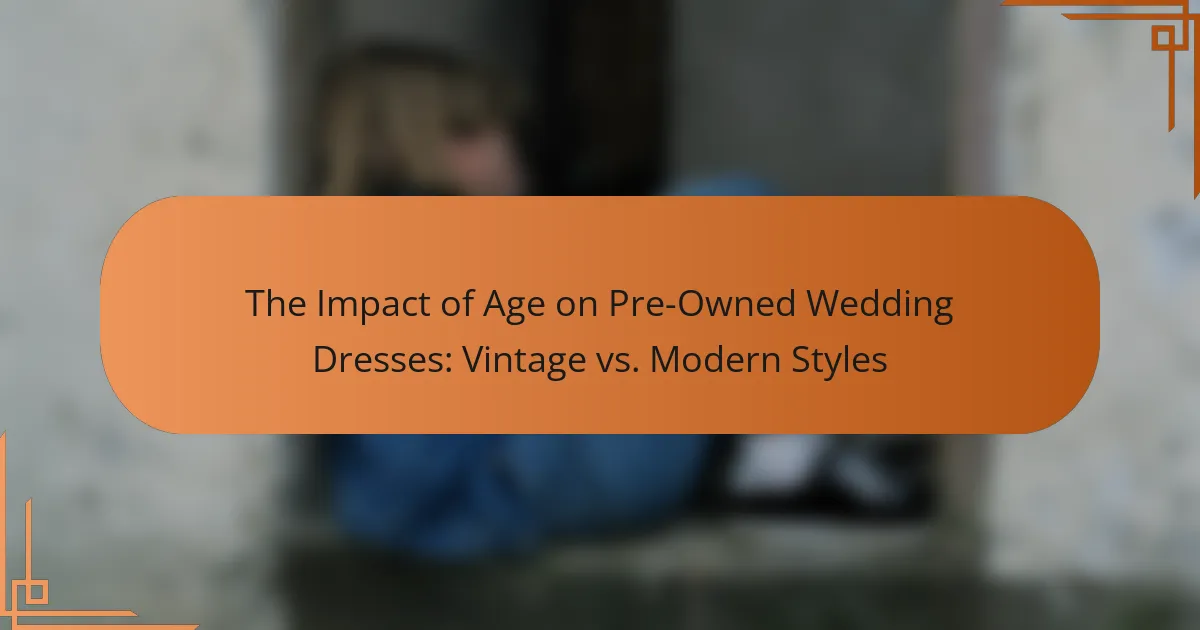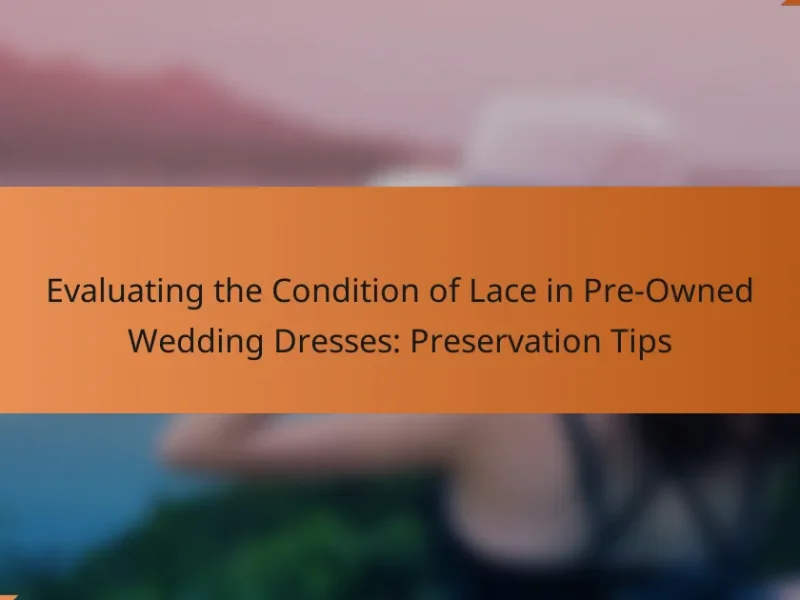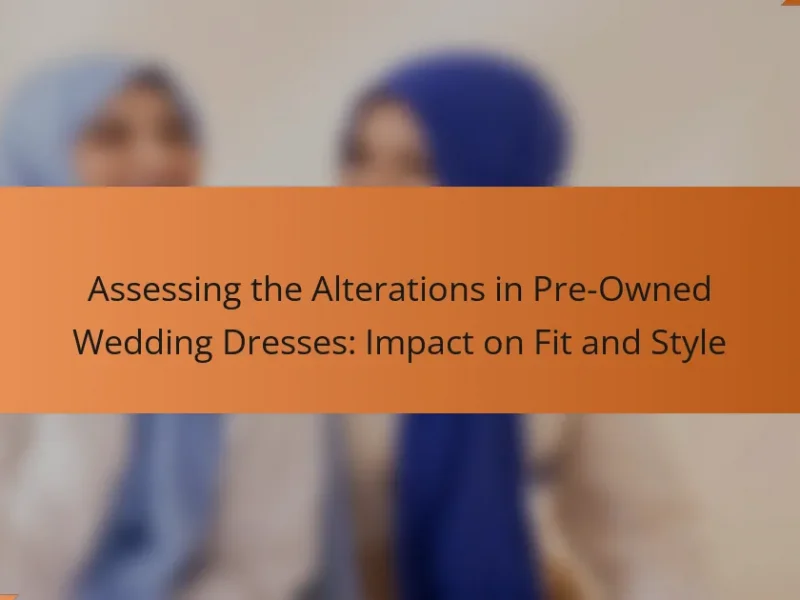The article examines the impact of age on pre-owned wedding dresses, focusing on the distinctions between vintage and modern styles. It highlights how the age of a wedding dress influences its design, condition, and market value, with vintage dresses often showcasing unique craftsmanship and higher demand among collectors. Modern pre-owned dresses are discussed in terms of their contemporary appeal and potential depreciation in value. Key considerations for brides include style, fit, condition, and budget, emphasizing the importance of these factors when choosing between vintage and modern options.
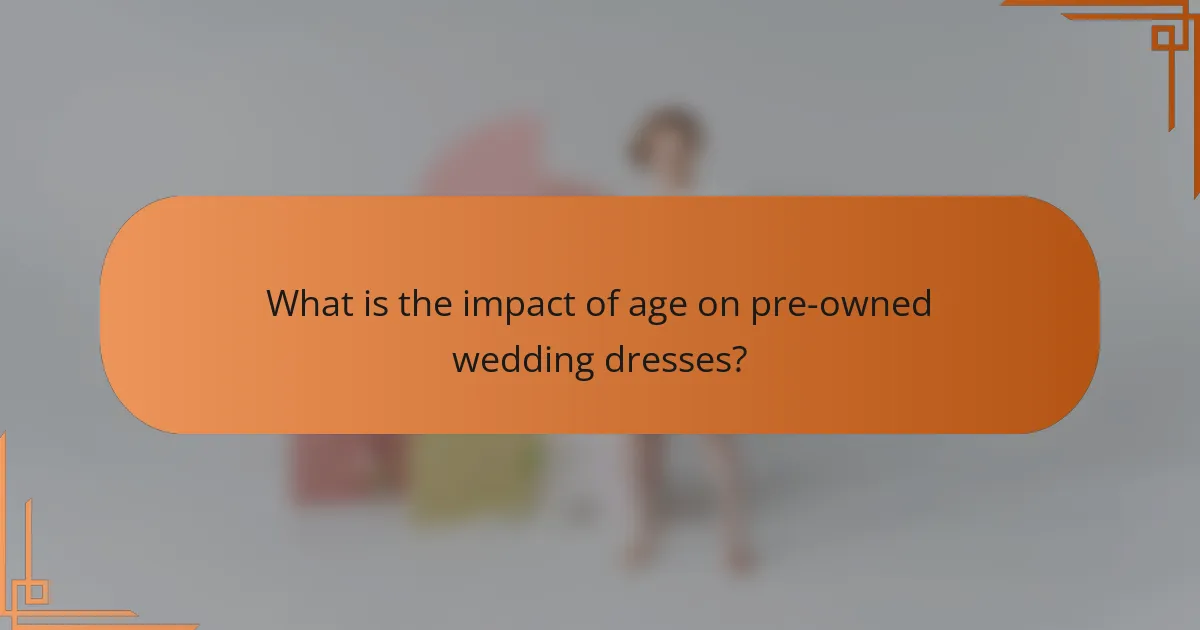
What is the impact of age on pre-owned wedding dresses?
The impact of age on pre-owned wedding dresses significantly influences their style, condition, and market value. Vintage wedding dresses often feature unique designs and fabrics that reflect the trends of their era. Modern pre-owned dresses tend to incorporate current fashion trends and materials.
Older dresses may show signs of wear, such as yellowing or fabric degradation. This can affect their desirability among buyers. However, some buyers specifically seek vintage styles for their character and history.
Market demand also varies with age. Vintage dresses can sometimes fetch higher prices due to their rarity and nostalgic appeal. Conversely, modern pre-owned dresses may appeal to a broader audience due to their contemporary design.
Overall, the age of a wedding dress plays a crucial role in its aesthetic appeal, condition, and resale value.
How do vintage and modern styles differ in pre-owned wedding dresses?
Vintage and modern styles differ significantly in pre-owned wedding dresses. Vintage styles typically feature intricate lacework, unique silhouettes, and historical design elements. These dresses often reflect the fashion trends of their respective eras, such as the flapper style of the 1920s or the bohemian influences of the 1970s. In contrast, modern styles tend to emphasize minimalism, clean lines, and contemporary fabrics. They often incorporate modern technology in their construction, resulting in more comfortable fits.
Additionally, vintage dresses may have unique embellishments and fabrics that are no longer commonly used. Modern dresses often prioritize practicality and wearability, catering to current bridal preferences. The market for vintage dresses is also characterized by a sense of nostalgia and individuality, appealing to brides seeking one-of-a-kind pieces. This distinction highlights how the age of a wedding dress influences its design, materials, and overall aesthetic.
What defines a vintage wedding dress compared to a modern one?
A vintage wedding dress is defined by its age, typically being at least 20 years old. Vintage dresses often feature classic silhouettes, intricate lace, and unique embellishments. These designs reflect the fashion trends of their respective eras. In contrast, modern wedding dresses tend to have contemporary cuts and minimalistic designs. They often utilize modern fabrics and construction techniques. Vintage dresses may exhibit wear and tear, adding character and history. Modern dresses prioritize comfort and ease of movement. The distinction lies in the aesthetic, craftsmanship, and historical context of the garment.
How does the age of a wedding dress influence its style and design?
The age of a wedding dress significantly influences its style and design. Vintage wedding dresses often feature intricate lacework, high necklines, and fuller skirts, reflecting the fashion trends of their time. Modern wedding dresses typically showcase minimalistic designs, sleek silhouettes, and a focus on comfort. Historical context plays a crucial role; for instance, dresses from the 1920s often have drop waists and flapper-inspired elements, while the 1980s are known for puffed sleeves and bold embellishments. Additionally, the materials used differ; older dresses may utilize heavier fabrics like satin, while contemporary options often incorporate lightweight materials like chiffon. Fashion evolution over decades has led to distinct aesthetics that characterize each era’s bridal wear.
Why are pre-owned wedding dresses becoming popular?
Pre-owned wedding dresses are becoming popular due to their affordability and sustainability. Many brides seek cost-effective options for their weddings. Pre-owned dresses often cost significantly less than new ones. This allows brides to allocate their budget to other wedding expenses. Additionally, the trend aligns with growing environmental consciousness. Purchasing pre-owned reduces waste and promotes recycling in the fashion industry. Statistics show that the second-hand market is expanding rapidly, with a 21% growth in 2021 alone. This shift reflects changing consumer values toward sustainability and financial prudence.
What are the benefits of choosing a pre-owned wedding dress?
Choosing a pre-owned wedding dress offers multiple benefits. First, it is often more affordable than buying new. For example, brides can save up to 50% on their dress costs. Second, pre-owned dresses contribute to sustainability. This choice reduces waste and promotes eco-friendly practices in the fashion industry. Third, many pre-owned dresses are unique. They may feature vintage designs that are not available in modern collections. Additionally, purchasing a pre-owned dress can support small businesses or individuals. This helps foster local economies and communities. Lastly, pre-owned dresses often come with a story. Many brides appreciate the history and character these dresses carry.
How does sustainability play a role in the demand for pre-owned dresses?
Sustainability significantly increases the demand for pre-owned dresses. Consumers are increasingly aware of the environmental impact of fast fashion. Purchasing pre-owned dresses reduces waste and minimizes resource consumption. Studies show that the fashion industry contributes to 10% of global carbon emissions. Choosing second-hand options helps lower this figure. Additionally, pre-owned dresses often carry unique styles that appeal to eco-conscious buyers. This combination of environmental awareness and fashion preference drives the market for pre-owned dresses.
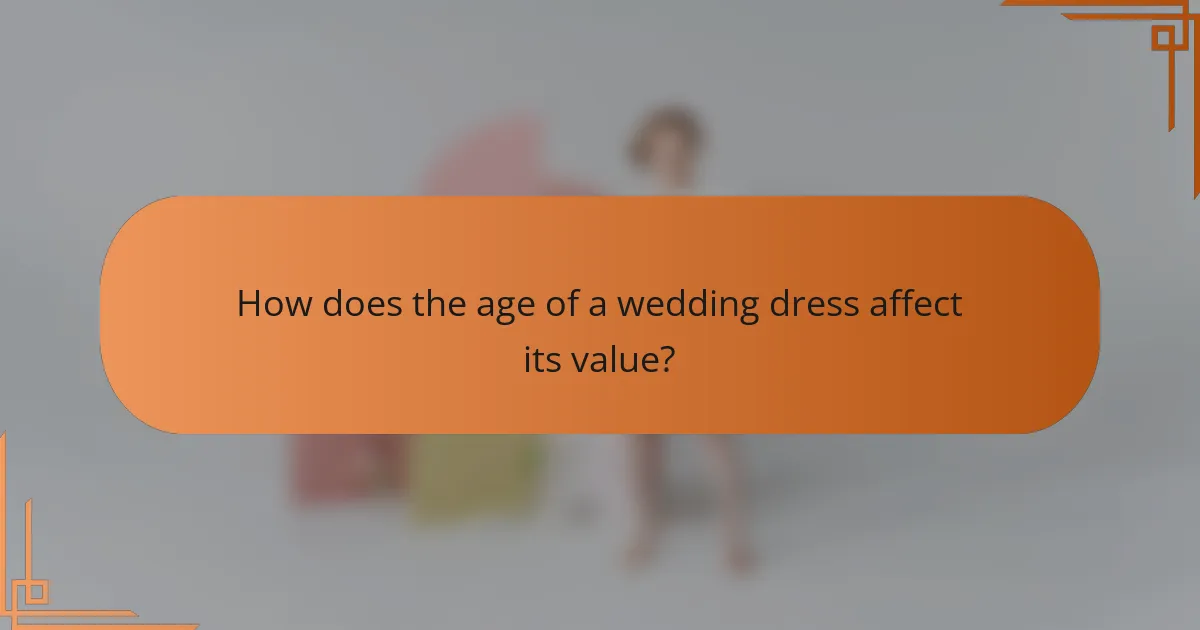
How does the age of a wedding dress affect its value?
The age of a wedding dress significantly affects its value. Generally, vintage wedding dresses can appreciate in value over time. Dresses from specific eras, like the 1920s or 1980s, often become sought after. Their rarity increases demand among collectors and fashion enthusiasts. Modern wedding dresses typically depreciate soon after purchase. This depreciation occurs due to trends changing quickly in contemporary fashion. The condition of the dress also plays a critical role in determining value. Well-preserved vintage dresses can command higher prices than newer, worn dresses.
What factors determine the value of vintage versus modern pre-owned wedding dresses?
The value of vintage versus modern pre-owned wedding dresses is determined by several factors. Age significantly influences value; vintage dresses often carry historical significance. Brand reputation also plays a role; well-known designers can elevate a dress’s worth. Condition is crucial; dresses in pristine condition fetch higher prices. Unique design elements may enhance value, particularly in vintage dresses. Market demand fluctuates, affecting both vintage and modern dress prices. Provenance, or the dress’s history, can increase its appeal and value. Lastly, cultural trends impact desirability; current styles may be more sought after than older designs.
How does condition influence the resale value of a wedding dress?
The condition of a wedding dress significantly influences its resale value. A dress in excellent condition typically commands a higher price. This is because buyers prefer garments that show minimal signs of wear. Conversely, a dress with visible damage or stains will have a reduced value. Research indicates that well-maintained dresses can retain up to 70% of their original retail price. In contrast, heavily worn dresses may only sell for 20% to 30% of their initial cost. Therefore, sellers should prioritize proper cleaning and storage to maintain value.
What market trends affect the pricing of vintage and modern wedding dresses?
Market trends affecting the pricing of vintage and modern wedding dresses include consumer preferences, economic conditions, and sustainability awareness. Consumer preferences shift towards unique and personalized designs, increasing demand for vintage dresses. Economic conditions influence disposable income, impacting spending on luxury items like wedding dresses. Sustainability awareness drives interest in pre-owned dresses, often elevating their market value. Additionally, social media trends and influencer endorsements can significantly boost the visibility and desirability of specific styles, affecting pricing.
What are the emotional aspects associated with pre-owned wedding dresses?
Pre-owned wedding dresses evoke various emotional aspects for brides. These dresses often carry stories and memories from previous owners. Many brides feel a sense of nostalgia and connection to the past. Choosing a pre-owned dress can symbolize sustainability and conscious consumerism. This choice may also bring feelings of uniqueness and individuality. Brides often appreciate the affordability of pre-owned dresses, which can alleviate financial stress. The act of wearing a dress with history can enhance the emotional significance of the wedding day. Overall, pre-owned wedding dresses can foster a blend of joy, sentimentality, and personal expression.
How do stories and histories impact the desirability of vintage dresses?
Stories and histories significantly enhance the desirability of vintage dresses. Each vintage dress carries unique narratives that connect buyers to past eras. These stories can include the dress’s origin, previous owners, or historical events associated with it. Such connections create emotional value, making the dresses more appealing. Vintage dresses often represent a specific time period, reflecting cultural trends and social changes. This historical context adds depth to their allure. Additionally, dresses with well-documented histories can fetch higher prices in the market. Collectors and fashion enthusiasts often seek pieces with rich backstories. Thus, the stories and histories tied to vintage dresses directly influence their desirability and market value.
Why do some brides prefer modern styles over vintage options?
Some brides prefer modern styles over vintage options due to contemporary aesthetics and trends. Modern wedding dresses often feature clean lines and minimalist designs. These styles align with current fashion preferences. Additionally, modern dresses may offer more comfortable fabrics and cuts. This can enhance the overall experience of wearing the dress. Brides also seek unique designs that reflect their personal style. Modern options often provide innovative features like detachable skirts or jumpsuits. The desire for individuality in a wedding dress drives many to choose modern styles.
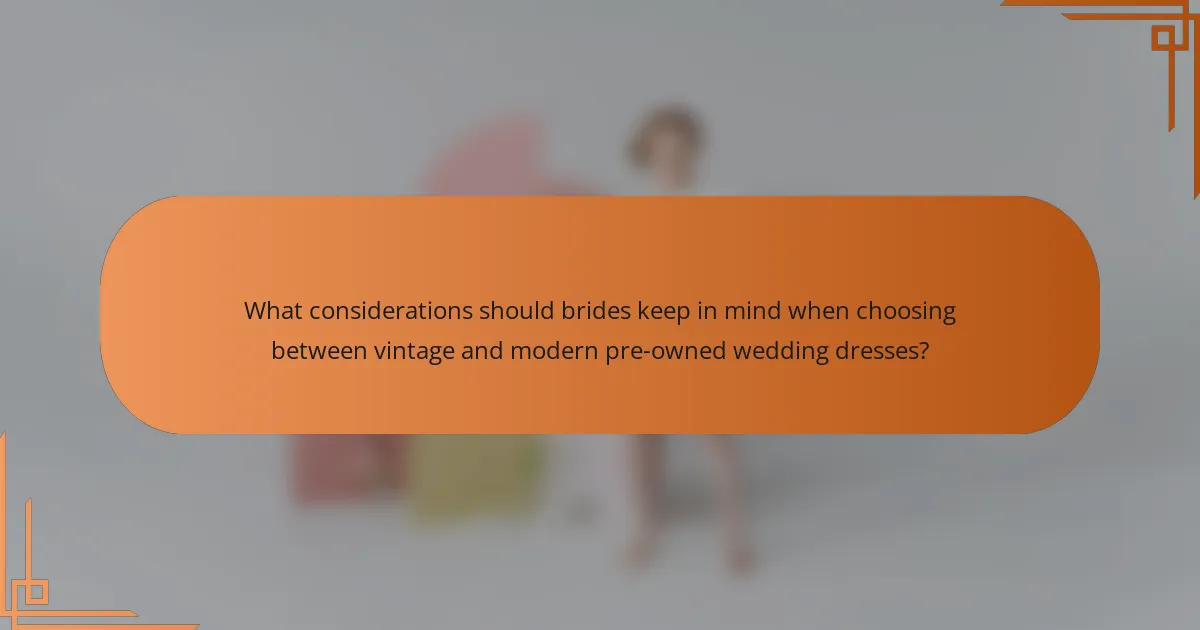
What considerations should brides keep in mind when choosing between vintage and modern pre-owned wedding dresses?
Brides should consider style, fit, and condition when choosing between vintage and modern pre-owned wedding dresses. Vintage dresses often feature unique designs and craftsmanship from past eras. Modern pre-owned dresses may offer contemporary styles and updated trends. Fit is crucial; vintage sizing may differ significantly from current standards. Brides should also assess the condition of the dress, looking for any signs of wear or necessary repairs. Additionally, brides might consider the emotional and historical value of vintage dresses versus the practicality and availability of modern options. Budget constraints can also influence the decision, as vintage dresses may vary in price based on rarity and designer.
How can brides assess the fit and comfort of pre-owned wedding dresses?
Brides can assess the fit and comfort of pre-owned wedding dresses by trying them on before purchase. They should check the dress size against their measurements. Comfort can be evaluated by moving in the dress, sitting, and walking. Brides should pay attention to any tightness or pinching. Additionally, inspecting the fabric for softness and breathability is important. Trying on dresses with similar styles can help in understanding fit. Seeking feedback from friends or family can provide additional perspectives. Finally, considering the dress’s age and condition can affect comfort levels.
What alterations might be necessary for vintage dresses?
Alterations for vintage dresses may include resizing, repairing seams, and updating closures. Vintage dresses often have unique sizing that may not fit modern body shapes. Resizing can involve taking in or letting out seams to achieve a better fit. Repairing seams is essential due to wear and tear over time. Updating closures, such as zippers or buttons, can enhance functionality and aesthetics. Additionally, adjusting the length may be necessary to suit current fashion trends. These alterations ensure that vintage dresses remain wearable and stylish.
How do modern designs accommodate different body types?
Modern designs accommodate different body types through inclusive sizing and adjustable features. Many brands offer a wide range of sizes, catering to diverse body shapes. Additionally, modern designs incorporate stretch fabrics for better fit and comfort. Customization options are increasingly available, allowing alterations to meet individual needs. Design elements like A-line silhouettes and empire waists flatter various figures. Research shows that inclusive fashion increases consumer satisfaction and engagement. Brands focusing on body positivity enhance their market reach by appealing to a broader audience.
What tips can help brides make the best choice for their wedding dress?
Brides can make the best choice for their wedding dress by considering their body type. Understanding body shape helps in selecting a flattering silhouette. Research shows that A-line dresses suit most body types. Additionally, brides should set a budget before shopping. This ensures they focus on options within their price range. It’s also important to consider the wedding theme. The dress should complement the overall aesthetic of the event. Trying on various styles is crucial. This allows brides to see what they feel comfortable in. Finally, seeking advice from trusted friends or family can provide valuable insights.
How can brides find reputable sellers for pre-owned wedding dresses?
Brides can find reputable sellers for pre-owned wedding dresses through several methods. Online marketplaces like Stillwhite and PreOwnedWeddingDresses are popular options. These platforms specialize in wedding attire and include reviews from previous buyers. Local bridal boutiques may also carry consignment dresses from previous brides. Checking social media groups focused on wedding dress exchanges can yield trustworthy sellers. Recommendations from friends or bridal forums can provide additional insights. Researching seller ratings and return policies is essential for ensuring a safe transaction. Verifying authenticity through seller communication can help confirm the dress’s condition and history.
What should brides look for during a fitting of a pre-owned dress?
Brides should look for overall fit, condition, and style during a fitting of a pre-owned dress. The dress must fit well in the bust, waist, and hips. Inspect the fabric for any signs of wear, such as fraying or discoloration. Check for missing beads or embellishments. Brides should also assess the dress’s comfort level while moving. Consider how the dress reflects personal style preferences. Ensure the dress can be altered if necessary. Research indicates that pre-owned dresses can vary widely in quality, making careful inspection crucial.
The main entity of the article is pre-owned wedding dresses, with a focus on the impact of age on their style, condition, and market value. The article examines the differences between vintage and modern styles, highlighting how each reflects distinct fashion trends and materials. It discusses factors influencing the desirability and pricing of these dresses, including condition, emotional aspects, and sustainability considerations. Additionally, the content addresses practical tips for brides when selecting pre-owned dresses, including fit assessments and reputable seller identification.
